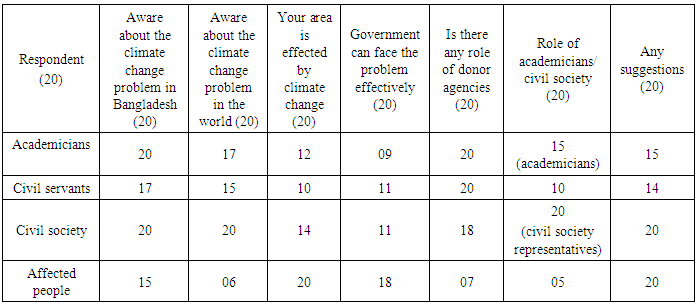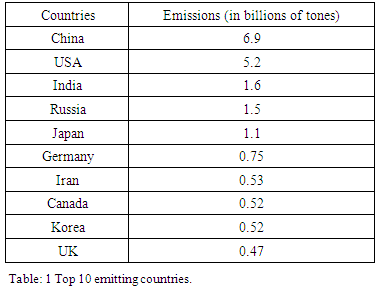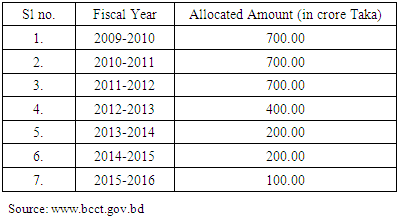-
Paper Information
- Paper Submission
-
Journal Information
- About This Journal
- Editorial Board
- Current Issue
- Archive
- Author Guidelines
- Contact Us
Resources and Environment
p-ISSN: 2163-2618 e-ISSN: 2163-2634
2016; 6(1): 1-8
doi:10.5923/j.re.20160601.01

Environment and Climate Change in Bangladesh: Challenges and the Role of Public Administration
Istiaque Hossain Molla
Lecturer (Bangladesh Studies), BRAC University, Bangladesh
Correspondence to: Istiaque Hossain Molla, Lecturer (Bangladesh Studies), BRAC University, Bangladesh.
| Email: |  |
Copyright © 2016 Scientific & Academic Publishing. All Rights Reserved.
This work is licensed under the Creative Commons Attribution International License (CC BY).
http://creativecommons.org/licenses/by/4.0/

Climate change is accepted as a major issue for Bangladesh due its extreme environmental vulnerability to climate hazards irrespective of climate change. It has a well-established scientific community addressing the issue, and was an early mover in the National Adaptation Program of Action (NAPA) process. Since then (1995) there have been a series of policy and institutional changes undertaken by government.
Keywords: Environment, Administration, Policy, Management
Cite this paper: Istiaque Hossain Molla, Environment and Climate Change in Bangladesh: Challenges and the Role of Public Administration, Resources and Environment, Vol. 6 No. 1, 2016, pp. 1-8. doi: 10.5923/j.re.20160601.01.
Article Outline
1. Introduction
- Environmental insecurity is one of the major threats for our country. It is one of the major problems. To deal with it government have to face so many problems. The government has already taken so many initiatives regarding these problems. Attended so many conferences and introduce climate change unit in the ministry. But for this the administrators specially the bureaucrats who work in the field level must play an important role. As the climate change issue is very important in our sub-continent. The administrators have to face so many natural disasters like ‘Nargis, Mohashen etc.’. The policies that government have established are effective for the people or not? This is a very burning question now-a-days. But this is not the main topic of this article. It is very difficult to implement the climate change projects in the field level without the involvement of the field level administrators. The bureaucrats who are actually working in the secretariat and involve in policy making are not able to look after this issue. But unfortunately it is true that the local level administrators like: District commissioner (DC), Upazila Nirbahi Officer (UNO) are not that much cordial to implement the policies. As a populated area Bangladesh is facing many problems. Especially in terms of changing seasons. We have found that the variables among the seasons which make people surprised. This research tries to find out the role of the civil servants and academicians as well as the civil society. The opinion affected people gave are also mentioned. The role of the civil society, NGO’s, donors and fund raising by the government are also discussed. Statement of the problem:We do not have enough information that how we should respond to the negative health effects of climate change. Secondly, it hampered the poor so e do not have enough sources to help the poor. Thirdly, challenge is political creating the conditions for low carbon living. And finally there is the question of how we adapt our intuitions to make climate change the priority it needs to be (The Lancet, 2011). Fourthly we do have lack of developed technologies. Objectives of proposed study: Research objectives refer to find out the answers of the pre fixed questions to conduct the research and gain new knowledge on that topic.The research objectives are here,1. The role of public administration in climate change programs in Bangladesh2. The effective role of civil society3. The role of donor agencies in climate change 4. Problems of the government officials and probable suggestionsResearch questions:The pre conditions of a research are to formulate some questions regarding the research topic to limit the research area or subject. The questions are:1. What is the role of the government regarding the climate change?2. People are aware about this issue or not?3. What is the role of the administrators/bureaucrats?
2. Research Methodology
- The success of the research mainly depends on the correct selection of the method. It’s not necessary that, we have to conduct the research, only with one method. We can combine2-4 methods for conducting a successful research. Primary Data Collection: I used some open ended questions and some closed questions. I took interview of a number of people (100) including academician (20), civil servants; who are working in the field level on climate change and disaster management issues and also the bureaucrats who are working in the central administration (secretariat) assigned for policy making (20) and effected people (40); from different areas. As we are only emphasize on rural areas but people from urban areas are also effected for this. So I consider both of the category.Secondary Data Collection: Information’s were taken from websites, national, international and ministries websites. Information’s are taken from daily newspapers. Qualitative and quantitative data were considered. I have also taken help from government policies. Definition of climate change:Climate change is the long-term shift in weather patterns in a specific region or globally. The weather is a set of all the phenomena occurring in a given atmosphere at a given time (IAC, 2011). Climate change is identified as an average weather condition of an area characterized by its own internal dynamics and by changing in external factors that affect climate. Climate change as the change resulting from long term direct and indirect activities that induces changes in the compared time which are much more than the natural change, according to UNFCC. Definition of Public Administration: Public administration is the implementation of government policyDefinition of Bureaucracy: A Bureaucracy is "a body of nonselective government officials" and/or "an administrative policy-making group.Bangladesh, scenery:Bangladesh lies between latitudes 20° and 27°N, and longitudes 88° and 93°E.Bangladesh is in the low-lying Ganges–Brahmaputra River Delta or Ganges Delta. This delta is formed by the confluence of the Ganges (local name Padma or Pôdda), Brahmaputra (Jamuna or Jomuna also known as "Yamuna"), and Meghna rivers and their respective tributaries. The Ganges unites with the Jamuna (main channel of the Brahmaputra) and later joins the Meghna to eventually empty into the Bay of Bengal. The alluvial soil deposited by these rivers has created some of the most fertile plains in the world. Bangladesh has 57 trans-boundary rivers, making water issues politically complicated to resolve – in most cases as the lower riparian state to India. Most parts of Bangladesh are less than 12 m (39.4 ft) above the sea level, and it is believed that about 10% of the land would be flooded if the sea level were to rise by 1 m (3.28 ft). (http://www.bdembassyusa.org).PopulationThe country's population now stands at 16 crore (Daily Star, 2011), which is 1.8 crore more than a decade ago- leave behind almost unimaginable ecological footprints. Bangladesh is the third most populated country in South-East Asia after India and Pakistan, which have 121.45 crore and 18.48 crore people, according to United Nations Population Fund. Its population now is higher than the combined total of Thailand, Myanmar, Sri Lanka and Singapore. Bangladesh ranked fifth most vulnerable country to climate change and hunger in an Action Aid research report. In the World Risk Index 2011, jointly conducted by United Nations University (UNU), Germany and the Institute of Environment and Security said that Bangladesh ranked sixth among countries that are most vulnerable to natural disasters, while second among the Asian countries ( Daily Star, 2011). Climate Change Incidents in Bangladesh:Straddling the Tropic of Cancer, Bangladeshi climate is tropical with a mild winter from October to March, a hot, humid summer from March to June. A warm and humid monsoon season lasts from June to October and supplies most of the country's rainfall. Natural calamities, such as floods, tropical cyclones, tornadoes, and tidal bores occur almost every year, combined with the effects of deforestation, soil degradation and erosion. The cyclones of 1970 and 1991 were particularly devastating. A cyclone that struck Bangladesh in 1991 killed some 140,000 people. In September 1998, Bangladesh saw the most severe flooding in modern world history. As the Brahmaputra, the Ganges and Meghna spilt over and swallowed 300,000 houses, 9,700 kilometres (6,027 mi) of road and 2,700 kilometres (1,678 mi) of embankment 1,000 people were killed and 30 million more were made homeless with 135,000 cattle killed, 50 square kilometres (19.3 sq mi) of land destroyed and 11,000 kilometres (6,835 mi) of roads damaged or destroyed. Two-thirds of the country was underwater. There were several reasons for the severity of the flooding. Firstly, there were unusually high monsoon rains. Secondly, the Himalayas shed off an equally unusually high amount of melt water that year. Thirdly, trees that usually would have intercept rain water had been cut down for firewood or to make space for animals. (Dhaka Tribune, 2015)The role of the government and public administration: Over the last 35 years, the Government of Bangladesh, with the support of development partners, has invested over $10 billion to make the country less vulnerable to natural disasters. These investments include flood management schemes, coastal polders, cyclone and flood shelters, and the raising of roads and highways above flood level. In addition, the Government of Bangladesh has developed state-of-the-art warning systems for floods, cyclones and storm surges, and is expanding community-based disaster preparedness. Climate resilient varieties of rice and other crops have also been developed.Ministry of Environment and Forest (MoEF):Established by the government aft er Bangladesh signed and ratifi ed the UNFCCC, the Ministry of Environment and Forest is the lead institution for work on climate change issues. The Ministry led the Initial National Communication (INCom) to the UNFCCC, the BCCSAP, and commissioned the preparation of the Second National Communication (SNC) to the UNFCCC (MoEF, 2002; MoEF-UNDP, 2005). MoEF directs all climate change related policy issues and represents the country at international negotiations under the UNFCCC, a number of UNFCCC committees, and at conferences on multinational environmental agreements. The chief international negotiator on climate change for Bangladesh is from MoEF.Inter-Ministerial CoordinationAlthough the strategic institutional framework for how government ministries are required to interact on climate change issues is not clearly articulated in the BCCSAP, the BCCSAP envisions climate change programming to function within a “multi-institutional architecture.” National institutions, which predominantly represent the interests of public sector institutions and their allied agencies (such as Trustee agencies formed under a certain ministry), are mandated to implement the BCCSAP 44-point agenda.The climate change action plan:The Climate Change Action Plan, which has been developed by the Government of Bangladesh in consultation with civil society, including NGOs, research organisations and the private sector, is a 10-year programme (2009-2018) to build the capacity and resilience of the country to meet the challenge of climate change. The needs of the poor and vulnerable, including women and children, will be prioritised in all activities under the Action Plan. The Climate Change Action Plan comprises immediate, short, medium and long-term programmes. The Climate Change Action Plan will be implemented under the overall guidance of the National Environment Committee, chaired by the Prime Minister. It will be coordinated by concerned Ministry of Environment and Forests. Programmes funded under the Plan will be implemented by Ministries or their agencies, with the involvement, as appropriate, of civil society and the private sector. In the first five year period (2009-13), the programme will comprise six pillars: Firstly, Food security, social protection and health; Secondly, Comprehensive disaster management; Thirdly, Infrastructure; Fourthly, Research and knowledge management; Fifthly, Mitigation and low carbon development; Finally, Capacity building and institutional development.Bangladesh Climate Change Strategy and Action Plan (BCCSAP):Bangladesh was one of the first countries to develop a climate change strategy and action plan. This evolved in two stages. The first strategic plan, developed during the tenure of the last Caretaker Government (2006-08), was heavily criticized by civil society organizations in Bangladesh for a lack of public participation, especially at the grassroots level, during the strategy development process. Th is immediately prompted the newly elected government to revise the final document in early 2009 (Asia Foundation, 2013).Sixth Five Year Plan (SFYP):A major step forward in the Government of Bangladesh’s plans to address the potential impact of climate change is demonstrated through Bangladesh’s Sixth Five-Year Plan (2011-2015). Unlike previous plans, the Sixth Five-Year Plan (2011-2015) pays signifi cant attention to climate change issues and dedicates an entire chapter to adaptation and mitigation strategies for addressing climate change, “Chapter 8: Environment, Climate Change, and Disaster Management for Sustainable Development.”Other Policies:Some elements of climate change adaptation are addressed through specific c sectoral policies (Ahmed, 2004; UO-Oxfam, 2008; Rahman et al., 2010). However, with the exception of the Coastal Zone Policy (MoWR, 2004), and the recently renewed National Agriculture Policy (MoA, 2011), climate change issues have not been sufficiently highlighted in the national policy regime. Given the importance of climate change and its potential adverse implications on economic development and people’s lives and livelihoods, revision of sectoral policies and explicit inclusion of climate change impacts and considerations in these policies were highlighted by survey respondents as priorities.The Role of Local Government:Local government institutions (LGIs), such as Union Parishads (UPs) and paurashavas, are entities that operate at the local level and therefore have a direct understanding of the needs of people in their communities. Elected through direct votes from the local population, the representatives live in the respective constituencies and act as the first point of contact for most of the issues affecting the community members’ lives and livelihoods. In addition, there are several standing committees within the local government that are related to climate change, e.g., disaster management, health, education, agriculture, etc.The Bangladesh Parliament:An All Party Parliamentary Group (APPG) on environment and climate change was formed in 2009. It has taken initiatives to provide orientation training to about 140 members of parliament (MPs) on climate change issues and their roles. The committee has been vocal within the national parliament on climate change issues.
3. Major Findings of the Research
- After completing this research I find out some problems which are harmful for Bangladesh. The areas which are affected by climate change are as bellow:Research Findings:
|
|
|
4. Future Direction
- After completing the research it is very clear that the affected people are not aware from this climate change effect in our society. In the analysis (Table:1) we have found that the civil servants are still showing their colonial attitudes towards the society. The academicians are not supposed to do a thankful job for the society. The civil society organizations are trying to do some campaign, round table discussion but those are not effective at all. They are not creating any pressure rather most of them are trying to convince the donors for fund raising for their organizations. The organization named BELA, its chief faced threat in 2014. Her husband was abducted from Narayngonj (a renowned and populated place in Bangladesh). It became a political issue and she claimed that her husband was abducted for working against the muscle power who are destroying our environment. (The Daily Star, 2014). But we have a hope that we can do something better for our future. The Prime Minister of Bangladesh in her recent visit to attend the fourth European Development Days (EDD) held in Sweden from 22-24 October 2009, convincingly argued and made a forceful demand for the required mitigation, adaptation, and technology transfer assistance for the most vulnerable to climate change (MVCs) like Bangladesh from those responsible for global warming and having the capacity to pay for the adaptation costs. She has been awarded as one of the winners of the ‘United Nations’ highest environmental accolade in recognizing Bangladesh’s far reaching initiatives to address climate change. (www.unep.org). But the corruption in using climate change fund is one of the burning case. To allocate the projects the government chose some NGOs’ which have no experience and idea about it. Only for political reasons they did it. It should be strongly prohibited.
Research Question
- Environment and climate change in Bangladesh:Challenges and the Role of Public AdministrationNAME:______________________________________________________________________AGE:________________________________________________________________________PROFESSION:________________________________________________________________MAILING ADRESS:__________________________________________________________________________________________________________________________________________PERMANANET ADRESS:____________________________________________________________________________________________________________________________________QUESTIONS:1. Are you aware about the climate change problem in the world? (a) Yes (b) No2. Are you aware about the climate change problem in Bangladesh? (a) Yes (b) No3. Your area is effected by climate change? (a) Yes (b) No4. Do you think government can face the problem? (a) Yes (b) NoExplaination:………………………………………………………………………………………5. Is there any role from the donor agencies? (a) Yes (b) NoExplanation:………………………………………………………………………………………6. Is there any role from the academician/civil society? (a) Yes (b) NoExplanation:………………………………………………………………………………………7. Any other Suggestions:…………………………………………
 Abstract
Abstract Reference
Reference Full-Text PDF
Full-Text PDF Full-text HTML
Full-text HTML

